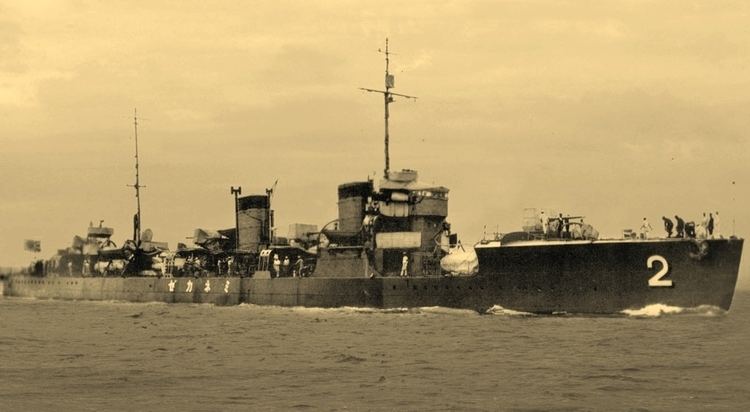Succeeded by Wakatake class | Preceded by Momi class | |
 | ||
Builders Maizuru Naval ArsenalMitsubishi-Nagasaki Operators | ||
The Minekaze class (峯風型駆逐艦, Minekazegata kuchikukan) was a class of fifteen 1st-class destroyers of the Imperial Japanese Navy. Obsolete by the beginning of the Pacific War, the Minekaze-class ships were relegated to mostly secondary roles, serving throughout the war as patrol vessels, high speed transports, target control vessels, and as kaiten (suicide torpedo) carriers. Most ultimately were lost to U.S. and British submarines.
Contents
Background
Construction of the large-sized Minekaze-class destroyers was authorized as part of the Imperial Japanese Navy's 8-4 Fleet Program from fiscal 1917–1920, as an accompaniment to the medium-sized Momi class with which they shared many common design characteristics.
Equipped with powerful engines, these vessels were capable of high speeds and were intended as escorts for the projected Amagi-class battlecruisers, which were ultimately never built.
Two vessels were authorized in fiscal 1917, and an addition five in fiscal 1918. Although none had been completed by the end of World War I, the Japanese Navy decided to continue the project as many older destroyers were in need of replacement. An additional five vessels were ordered in fiscal 1919, and a final three in fiscal 1920. However, the final three vessels were built to a different design and have a different enough silhouette that they can be regarded as a separate sub-class.
The new destroyers were fast and powerful ships that were equal to any of their foreign contemporaries.
Design
Coming between the foreign designed vessels of the earlier part of the century and the innovative Kagerō and Fubuki 'Special Type' destroyers of the 1930s, the Minekaze class was a significant transitional design for the Imperial Japanese Navy. Minekaze represented a complete break from previous practice of closely following British designs and methods.
The Minekaze class incorporated a number of distinctive design innovations including a lengthened forecastle with a break forming a well deck immediately forward of the bridge. This arrangement offered the advantage of a low, semi protected area for the forward torpedo tubes albeit at the cost of becoming awash in heavy seas.
The engines utilized four Kampon boilers running two-shaft geared turbines at 38,500 shp, yielding a rated speed of 39 knots (72 km/h). However, as with previous designs, high fuel consumption meant limited range.
Armament consisted of four Type 3 120 mm 45 caliber naval guns, six 21-inch (533 mm) torpedo tubes in three sets of double launchers and two 7.7 mm machine guns. Ships of this class could also be equipped to carry up to 20 mines.
Nokaze sub-class
The final three vessels in the Minekaze series incorporated a number of improvements gained through operational experience, and form a separate sub-class. The primary difference was in the arrangement of the aft armament. With the Minekaze class, the aft guns were pedestal-mounted along the centerline, with two double torpedo launchers in between. This severely limited the arc of fire of the No. 3 gun. The improved design had a better gunnery fire control system and improved ammunition magazine arrangements. Gun and torpedo positions were changed: the No. 3 gun formerly mounted aft of the second funnel was moved further aft to the "X" position. Torpedo mounts No. 2 and No. 3 were moved closer together and the searchlight platform formerly between them was moved forward to just aft of the second funnel.
Operational history
Commissioned during the 1920s, the Minekaze-class ships were the mainstay of the Imperial Japanese Navy destroyer squadrons throughout the 1930s until gradually replaced by more advanced types.
In 1938, Okikaze was disarmed, but in 1941 with the war fast approaching she remounted her guns. Nadakaze and Shimakaze were down-rated to patrol boats in 1939 and 1940. In 1939 Sawakaze was used as an aircraft rescue ship at Tateyama Naval Air Station, but reverted to her original role at the outbreak of the war.
